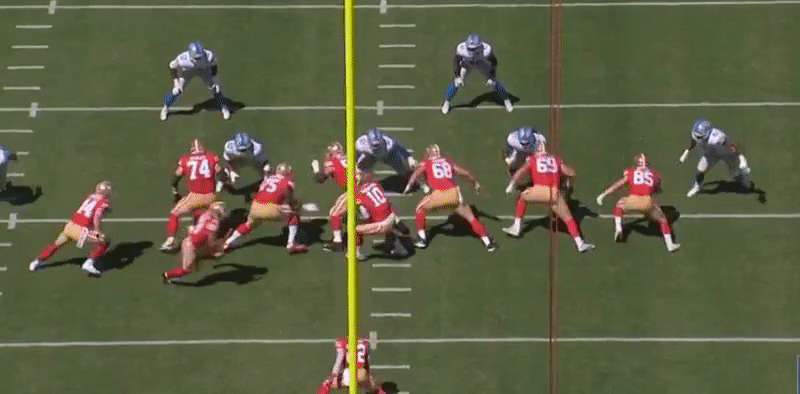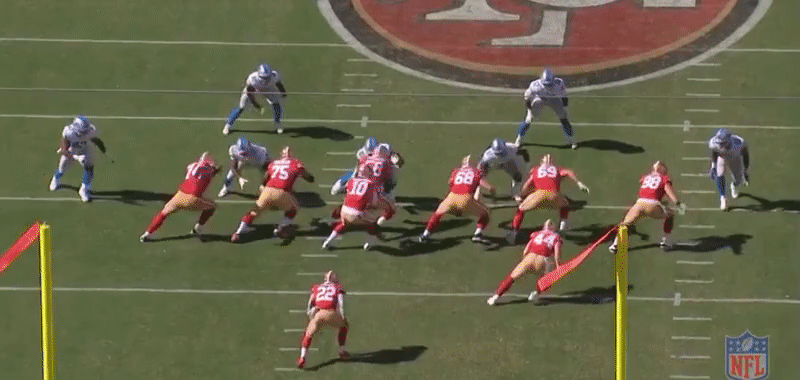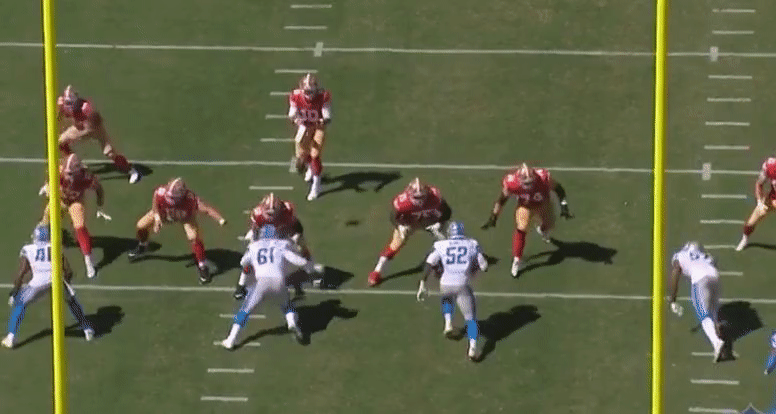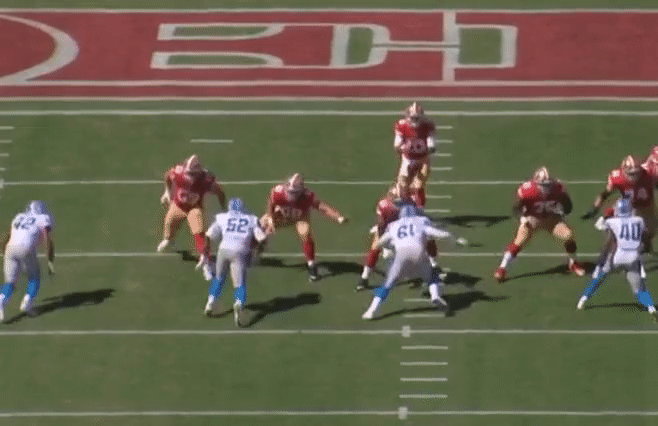Detroit Lions film review: 5 observations vs. 49ers
 Justin Rogers
Justin RogersAllen Park — Two weeks into the season, two losses. That's not where many expected the Detroit Lions to be with Matt Patricia at the helm, but here we are.

If you’re an optimist, which is essentially a requirement for any long-term fan of the franchise, you’re looking at how the team fought back from a 17-point fourth-quarter deficit and nearly beat the 49ers on Sunday. At least things appear to be trending in the right direction, compared to the roll-over-and-die finish against the Jets in the opener.
And if you’re a pessimist, the season is already over and you’re a masochist, seeking some salt for your wounds.
Regardless of why you’re reading, I’m happy you stopped by for this week’s batch of film study observations.
Kenny G plays 'em to sleep
Things aren’t all bad. Second-year receiver Kenny Golladay continues to look like he’s making even greater-than-expected strides in his development. He finished with six catches for 89 yards and a touchdown.
We need to talk about that touchdown, because it was the rare confluence of great play-calling and execution.
First, the call. The Lions come out with three wide receivers, LeGarrette Blount in the backfield and tight end Levine Toilolo off left tackle. It’s a personnel grouping that doesn’t hint, one way or the other, toward pass or run.
More:Lions' Stafford struggling to get deep passing success
More:Browns trade Josh Gordon to Patriots, who play Lions
More:Lions' Patricia says he'll ask NFL to take look at Quandre Diggs' penalty
But pre-snap, quarterback Matthew Stafford taps his left foot, motioning in Golladay, the lone receiver to the left, tight to the formation. And while it’s not the case every time, this typically indicates a run.
The bait has been cast.
On the snap, Golladay hints he might have invested in some acting classes this offseason. He expertly feigns a block on safety Jaquiski Tartt, who is lined up in the box. The sell of the block gets cornerback Ahkello Witherspoon, the man responsible for covering Golladay, to bite hard. The corner two steps toward the backfield on the play-action and by the time he realizes what’s going on, the receiver has five yards of separation and a lot of green in front of him.
Stafford quickly turns and fires, hitting Golladay in stride. A 49ers defender doesn’t make contact until the receiver is inside the 5, where he spins through the tackle attempt and dives across the goal line for the score.

Golladay has been excellent on many fronts. His route running is improved, he’s been Detroit’s best perimeter blocker and this savvy move, which led to a 30-yard score, adds to the level of trust he’s building with the coaching staff.
Roger Craig reborn
Raise your hand if you’ve heard of Matt Breida. OK, how many of you with your hand up play in three or more fantasy leagues? That’s what I thought.
Undrafted out of Georgia Southern last year, he had a quietly productive rookie year, averaging 4.4 yards on 105 carries, while showing some versatility with 21 catches out of the backfield. Jerick McKinnon’s ACL injury, suffered days before the start of the season, opened the door up for Breida to have a bigger role and impact this year.
But come on, this is ridiculous.
On his first touch of the game, Breida reminded us what we already knew, the Lions haven’t figured out how to stop the run.
The 49ers lined up up in I-formation, but motioned fullback Kyle Juszczyk off left tackle, balancing their line with tight end George Kittle to the right.
The handoff to Breida was an inside zone concept against Detroit’s seven-man box (five on the line and two linebackers). Juszczyk and left guard Laken Tomlinson (remember him?) pulled to the right.
Tomlinson walled off Lions linebacker Devon Kennard to the outside as Juszczyk led Breida through the right-side C gap, off tackle. Kittle got to the second level to seal linebacker Jarrad Davis inside, while Juszczyk bodied collapsing cornerback Teez Tabor.
That left Breida one-on-one with safety Glover Quin, who the back was able to shake with a shoulder dip and cut back inside before being brought down by Tabor from behind, 20 yards down the field.

Breida broke a second big run late in the second quarter. This time, Juszczyk was offset, in an H-back alignment to the left and tight end Garrett Celek motioned to that side pre-snap. As the ball is snapped, the entire line, plus Celek, slide left. The fullback leads between the left tackle and tight end, but Breida likes the wide lane between the guard and tackle on the stretch zone run.
Once again, the Lions are blocked well, except for Davis, who has a shot at Breida in the hole, but whiffs. The gain is 20 and might have been more had cornerback Nevin Lawson not beat his block on the perimeter and funneled Breida back inside.
Not that in mattered. The next play, Breida took it to the house from 66 yards out.
Flip the pre-snap setup from the previous play, with Juszczyk offset to the right and Celek motioning left to right before the snap. This time Juszczyk leads through the B gap and Breida follows. Celek is able to wall off defensive end Romeo Okwara on his own — an impressive and valuable contribution by any tight end — allowing right tackle Mike McGlinchey to shoot into the second level and eliminate Davis.
Guard Mike Person also delivers a key block, getting across the body of defensive tackle Ricky Jean Francois, keeping him inside to maintain Breida’s lane.
The back comes through untouched and deep safety Quandre Diggs is the only man with a shot to limit the damage, but he loses his footing as Breida cuts sharply back inside. A great downfield effort by wide receiver Pierre Garçon, blocking Nevin Lawson, was the final piece to the touchdown puzzle.

Ansah-less sack attack
We’ve talked all offseason about the difficulty the Lions could have generating a pass rush, but that task seemed impossible without Ziggy Ansah in the lineup. But some creative rushes and some strong individual efforts from the linebackers resulted in six sacks against the 49ers.
There was some talk after the game that quarterback Jimmy Garoppolo was holding on to the ball too long, leading to those sacks, so let’s take a look at them individually.
■ On the first, the 49ers stacked their line with two tight ends off right tackle and ran play-action to running back Alfred Morris, who stayed in to protect after the fake. That left only two routes being run and the Lions covered both well, taking away Garoppolo’s reads.
As the quarterback bounced around in the pocket, Davis transitioned from his run-gap assignment to a pass rush, looping wide around the left side of the 49ers' formation and coming in clean to drop the quarterback. The hit came 4.2 seconds after the ball was snapped.

■ On the next snap, Kennard only needed 2.9 seconds to get to Garoppolo. Coming off the left side, he chopped past McGlinchey to get the edge. Again, the coverage was good, particularly Diggs in the nickel, who jammed Kittle, the primary read.

■ In the second quarter, it was again Diggs taking away Kittle, and to a lesser extent cornerback Darius Slay covering up Garcon, the secondary option, that allowed the rush to get home. This time it was Eli Harold joining the party.
Rushing from a wide alignment on the right side, Harold had an inside/outside option on his rush. He opted to take the inside path, between the tackle and guard and was able to squeeze through. He also got a hand up on his way to the QB, potentially causing Garoppolo to pull the ball down. Time of sack, 3.4 seconds.

■ My personal favorite from the six sacks was Christian Jones’ late in the second quarter. Similar to Golladay’s touchdown explored above, Jones’ set his play up with subtlety.
Pre-snap, Jones lined up on the line, shaded to the right shoulder of the right guard. Once the ball was snapped, Jones aggressively came forward three strides before acting like he was dropping back in coverage. The guard bit on the deception and instantly turned his attention to helping with Kennard off the edge. That created a clear path for Jones to the QB.
The play took 3.0 seconds to develop and Detroit’s man coverage on the back end did well to take away the receiving options.

■ The team’s fifth sack came in the fourth quarter and was a group effort. Francois got the initial pressure, beating his block and forcing Garoppolo from the pocket. The scramble lane was then shut down by Okwara, forcing the QB to bounce outside where he was chased down by Davis.
Francois’ pressure impacted the quarterback at 3.2 seconds, but Davis didn’t bring down Garoppolo until nearly eight seconds after the snap. The primary read on the play was Juszczyk, coming out of the backfield on play-action, but Jones did a nice job picking him up. Francois was there before Garoppolo could move to his second read.
■ Kennard netted Detroit’s final sack, a clutch play that gave the offense a chance to win the game in the closing minutes.
The protection was faulty. The 49ers assigned Kittle to block Kennard, but from an h-back alignment, giving the edge rusher an opportunity to get plenty of momentum. Kennard easily drove Kittle back on a bull rush and was able to shed the block and stop the quarterback as he attempted to roll out away from the pressure. It took all of 2.7 seconds.
In conclusion, coverage definitely played a role. But that’s the case with most sacks. In this game, I can really only blame Garoppolo for holding on to the ball too long on Davis’ first sack. You could argue the same with Davis’ second, but that was an athletic play by the linebacker, stopping the passer while he was trying to make something happen with his feet.
Offensive artistry
I wrote about it last week, but watching it closely, you really have to appreciate the creativity of the 49ers offense.
The usage of the highly athletic Juszczyk was particularly impressive. The 49ers are able to comfortably line him up all over the field and utilize various motions to create matchup issues with him out of the backfield.
The team actually does this with a number of their offensive players, from Kittle to Breida to receiver Dante Pettis, who slid into the backfield on a key third-down snap that confused the Lions.
San Francisco also stayed true to their reputation for using tempo, regularly rushing to the line and snapping the ball. They caught the Lions sleeping a couple of times, including a play early in the game where they snuck Breida out wide and fired him a quick pass for a first-down conversion before the Lions sorted out coverage responsibilities.
They’re still a little light on weapons, but in another year or two, this could be one the NFL’s top offenses, thanks to the mind of coach Kyle Shanahan.
Deep-passing woes
We hit on the struggles more extensively in another article today, but wanted to come back to Stafford’s deep-passing woes. He took five shots downfield and had a man open on four of them.
Stafford had a clean pocket on three of the throws and none of the angles suggested that his follow through was impacted in a meaningful way on any of the five. Only the final shot, a desperation heave to Golladay, required Stafford to significantly move within the pocket and reset his feet.
On the first, at the end of the first half, Jones got a clean release off the line, but Stafford let go prematurely, overshooting his intended target by five yards.

Stafford missed Jones down the left sideline a second time to start the fourth quarter, this time by maybe a yard on the double move. Again, the receiver was not restricted in his route.
On both throws, Stafford’s weight distribution seemed to linger on his back foot, which can certainly impact trajectory accuracy.
The next series, Stafford missed Jones a third time, with the receiver splitting a pair of deep defenders. This throw wasn’t only long, but also behind the in-cutting Jones. With the entire right side of the field open, an in-stride throw potentially goes for a touchdown.
Finally, Stafford overshot another would-be touchdown with five minutes remaining. This time it was Golladay, running a deep crossing pattern from the right slot, who got open.

It’s a troubling pattern, but the issue appears mechanical and therefore easily correctable. The Lions have committed to putting extra emphasis on deep throws in practice this week, so we’ll see if it pays off against the Patriots on Sunday night.
jdrogers@detroitnews.com
Twitter: @Justin_Rogers